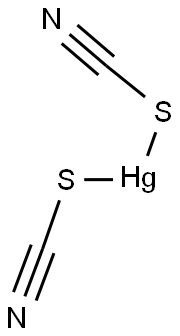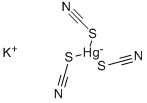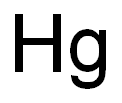MERCURIC THIOCYANATE
Synonym(s):Mercuric isothiocyanate;Mercuric sulfocyanide;Mercuric thiocyanate;Mercury di(thiocyanate);Thiocyanic acid, mercury(II) salt
- CAS NO.:592-85-8
- Empirical Formula: C2HgN2S2
- Molecular Weight: 316.75
- MDL number: MFCD00011039
- EINECS: 209-773-0
- SAFETY DATA SHEET (SDS)
- Update Date: 2024-12-18 13:37:16

What is MERCURIC THIOCYANATE?
Description
Mercury thiocyanate is a white, odorless powder. Molecular weight= 316.79; Freezing/Melting point=about 165℃ (decomposes). Slightly soluble in cold water.
Chemical properties
Mercuric thiocyanate is an inorganic chemical substance. It is a stable solid at room temperature, and depending upon the purity, it appears as odourless white crystalline powder or grey. It is insoluble in water and denser than water and sinks in water. On decomposition, mercuric thiocyanate releases hazardous substances such as cyanide vapours, vapours of mercury, oxides of nitrogen (NO, NO2), and oxides of sulphur (SO2, SO3). Mercury thiocyanate has limited uses in chemical synthesis.
Chemical properties
Mercury thiocyanate is a white, odorless powder.
The Uses of MERCURIC THIOCYANATE
For Pharaoh's serpents (fireworks); intensifier in photography.
The Uses of MERCURIC THIOCYANATE
Mercury(II) thiocyanate is used as a precursor to potassium tris(thiocyanato)mercurate(II) and cesium tris(thiocyanato)mercurate(II). It is also used in the determination of chloride ions in water by UV-visible spectroscopy. Further, it acts as a catalyst for the addition of thiocyanic acid to alkynes.
Air & Water Reactions
Insoluble in water.
Reactivity Profile
MERCURIC THIOCYANATE decomposes into its elements at about 165°C. Burns readily in air to generate a coil of cohesive ash resembling a serpent (hence used in a firework: Pharaoh's serpents). Swells up to many times its original volume if heated [USCG, 1999]. Soluble in dilute hydrochloric acid [Merck]. Incompatible with strong oxidizing agents.
Hazard
Highly toxic by ingestion, inhalation, and skin absorption.
Health Hazard
Mercuric thiocyanate causes severe eye and skin irritation with possible burns and causes digestive and respiratory tract irritation with possible burns. It may impair fertility, may cause harm to the unborn child, is harmful if inhaled, may cause allergic skin reaction, may cause kidney damage, may cause CNS effects, is light sensitive, and is a severe marine pollutant. Contact with acids liberates very toxic gas. The target organs include kidneys, CNS, reproductive system, eyes, and skin.
Safety Profile
A poison by ingestion and intraperitoneal routes. Moderately toxic by skin contact. Thermally unstable and decomposition may be vigorous. When heated to decomposition it emits very toxic fumes of Hg, NOx, SOx, and CN-. See also MERCURY COMPOUNDS and CYANATES.
Potential Exposure
Mercury thiocyanate is used in photography and fireworks.
First aid
If this chemical gets into the eyes, remove any contact lenses at once and irrigate immediately for at least 15 min, occasionally lifting upper and lower lids. Seek medical attention immediately. If this chemical contacts the skin, remove contaminated clothing and wash immediately with soap and water. Seek medical attention immediately. If this chemical has been inhaled, remove from exposure, begin rescue breathing (using universal precautions, including resuscitation mask) if breathing has stopped and CPR if heart action has stopped. Transfer promptly to a medical facility. When this chemical has been swallowed, get medical attention. Give large quantities of water and induce vomiting. Do not make an unconscious person vomit. Antidotes and special procedures for medical personnel: The drug NAP (n-acetyl penicillamine) has been used to treat mercury poisoning, with mixed success. Note to physician: For severe poisoning BAL [British AntiLewisite, dimercaprol, dithiopropanol (C3H8OS2)] has been used to treat toxic symptoms of certain heavy metals poisoning including mercury. Although BAL is reported to have a large margin of safety, caution must be exercised, because toxic effects may be caused by excessive dosage. Most can be prevented by premedication with 1-ephedrine sulfate (CAS: 134-72-5).
storage
Color Code—Blue: Health Hazard/Poison: Store in a secure poison location. Prior to working with this chemical you should be trained on its proper handling and storage. Store in tightly closed containers in a cool, wellventilated area away from light, heat, and acids, including fumes.
Shipping
UN1646 Mercury thiocyanate, Hazard Class: 6.1; Labels: 6.1-Poisonous materials.
Purification Methods
Recrystallise it from H2O, and it can give various crystal forms depending on conditions. Its solubility in H2O is 0.069% at 25o, but is more soluble at higher temperatures. It decomposes to Hg above 165o. Poisonous. [Mason & Forgeng J Phys Chem 35 1121 1931, Birckenbach & Kolb Chem Ber 68 919 1935.]
Incompatibilities
Incompatible with oxidizers (chlorates, nitrates, peroxides, permanganates, perchlorates, chlorine, bromine, fluorine, etc.); contact may cause fires or explosions. Keep away from alkaline materials, strong bases, strong acids, oxoacids, epoxides. Mercury thiocyanate is sensitive to heat; expands to many times its original volume and then decomposes at freezing/melting point forming toxic fumes of sulfur oxides, mercury cyanide, and nitrogen oxides. Contact with acid or acid fumes causes release of toxic mercury and cyanide vapors. Incompatible with chlorine, reducing agents such as hydrides, sulfides
Waste Disposal
Small amounts may be destroyed by alkaline hydrolysis. Admixture with alkali can be followed by soil burial. Larger quantities can be disposed of by incineration in admixture with acetone or xylene and using effluent gas scrubbing. Do not reuse empty container; proper disposal required.
Properties of MERCURIC THIOCYANATE
| Melting point: | 165 °C (dec.) (lit.) |
| Density | 3.71 g/mL at 25 °C (lit.) |
| Flash point: | 120 °C |
| storage temp. | Store at RT. |
| solubility | Methanol (Slightly) |
| form | Powder |
| color | White to pale yellow |
| Water Solubility | Soluble in dilute hydrochloric acid, potassium cyanide and ammonia. Slightly soluble in alcohol and ether. Insoluble in water. |
| Sensitive | Hygroscopic |
| Merck | 14,5890 |
| BRN | 3561344 |
| Stability: | Stable. Incompatible with strong acids. May be light or moisture sensitive. |
| CAS DataBase Reference | 592-85-8(CAS DataBase Reference) |
| EPA Substance Registry System | Mercuric thiocyanate (592-85-8) |
Safety information for MERCURIC THIOCYANATE
| Signal word | Danger |
| Pictogram(s) |
 Skull and Crossbones Acute Toxicity GHS06  Health Hazard GHS08  Environment GHS09 |
| GHS Hazard Statements |
H373:Specific target organ toxicity, repeated exposure H410:Hazardous to the aquatic environment, long-term hazard |
| Precautionary Statement Codes |
P262:Do not get in eyes, on skin, or on clothing. P273:Avoid release to the environment. P280:Wear protective gloves/protective clothing/eye protection/face protection. P314:Get medical advice/attention if you feel unwell. |
Computed Descriptors for MERCURIC THIOCYANATE
MERCURIC THIOCYANATE manufacturer
Anand Agencies
New Products
(S)-3-Aminobutanenitrile hydrochloride 4-Methylphenylacetic acid N-Boc-D-alaninol N-BOC-D/L-ALANINOL Tert-butyl bis(2-chloroethyl)carbamate 3-Morpholino-1-(4-nitrophenyl)-5,6-dihydropyridin- 2(1H)-one Furan-2,5-Dicarboxylic Acid Tropic acid 1-Bromo-3,5-Di-Tert-Butylbenzene S-2-CHLORO PROPIONIC ACID ETHYL ISOCYANOACETATE 2-Bromo-1,3-Bis(Dimethylamino)Trimethinium Hexafluorophosphate 4-IODO BENZOIC ACID 3-NITRO-2-METHYL ANILINE 1-(2,4-DICHLOROPHENYL) ETHANAMINE (2-Hydroxyphenyl)acetonitrile 4-Bromopyrazole 2-(Cyanocyclohexyl)acetic acid 4-methoxy-3,5-dinitropyridine 1-(4-(aminomethyl)benzyl)urea hydrochloride 2-aminopropyl benzoate hydrochloride diethyl 2-(2-((tertbutoxycarbonyl)amino) ethyl)malonate tert-butyl 4- (ureidomethyl)benzylcarbamate Ethyl-2-chloro((4-methoxyphenyl)hydrazono)acetateRelated products of tetrahydrofuran






You may like
-
 Mercury(II) thiocyanate CAS 592-85-8View Details
Mercury(II) thiocyanate CAS 592-85-8View Details
592-85-8 -
 Mercury(II) thiocyanate CAS 592-85-8View Details
Mercury(II) thiocyanate CAS 592-85-8View Details
592-85-8 -
 Mercuric Thiocyanate extrapure CAS 592-85-8View Details
Mercuric Thiocyanate extrapure CAS 592-85-8View Details
592-85-8 -
 Mercuric Thiocyanate extrapure AR CAS 592-85-8View Details
Mercuric Thiocyanate extrapure AR CAS 592-85-8View Details
592-85-8 -
 Mercuric thiocyanate, GR 99%+ CAS 592-85-8View Details
Mercuric thiocyanate, GR 99%+ CAS 592-85-8View Details
592-85-8 -
 Mercuric thiocyanate CAS 592-85-8View Details
Mercuric thiocyanate CAS 592-85-8View Details
592-85-8 -
 Mercuric thiocyanate 99% AR CAS 592-85-8View Details
Mercuric thiocyanate 99% AR CAS 592-85-8View Details
592-85-8 -
 MERCURIC THIOCYANATE AR CAS 592-85-8View Details
MERCURIC THIOCYANATE AR CAS 592-85-8View Details
592-85-8